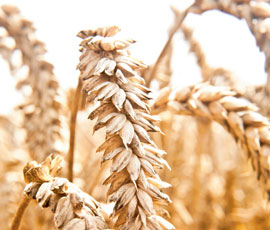Innovative wheat breeding can deliver faster results

Accelerated genetic techniques mean wheat varieties with drought tolerance, better disease resistance and higher yields could be available in the market in as little as seven years.
Wheat breeders are using new genetic techniques that can dramatically increase the speed at which wheat varieties enter the market, says Ed Flatman, senior wheat breeder at RAGT Seeds.
Previously, under traditional breeding processes, breeders had to rely on selecting the best conventionally crossed lines by eye and in the field.
But now a wealth of genetic information is helping breeders make early decisions in the laboratory and glasshouse so they can better understand wheat crosses by the time they reach the field, says Mr Flatman.
The technology is allowing RAGT to locate individual genes that could each give a yield increase of 1-2%.
“We can increase the yield stepwise if we can find three to four genes to stack in one breeding cycle,” explains Mr Flatman. “There’s going to be lots – tens, hundreds – of others that have very small effects, but if we can understand these bigger effects we can accumulate them and identify them.
“Importantly, we can start to make the selection in the glasshouse before we even get to the field.”
More than seven million winter wheat lines are produced each year through RAGT’s network of European breeding sites.
Understanding these lines as well as using sophisticated marker-assisted breeding is helping researchers make progress in improving key characteristics, such as durable multiple disease resistance, protein and starch functionality.
“Tracking genes with increasing precision is allowing us to fix trait combinations we don’t want to lose as we make improvements in other areas,” says Mr Flatman.
“It also allows us to exclude defeated genes, such as rust genes from parent variety lines broken down by disease mutations.”
For example, RAGT’s candidate variety Relay has the highest resistance rating of nine for yellow rust in the HGCA Recommended List.
Understanding the wheat genome, which is five times larger than the human genome, has allowed us to breed the variety with a background rust rating of six, says Mr Flatman.
“So if, or when, there is a rust mutation that bypasses the gene responsible for the rating of nine, there is still a valuable gene in place to prevent the variety breaking down completely in the field.”
This so-called “gene-stacking” is being used to harness yield and other beneficial traits in a variety – such as stress resistance, plant maturity or plant height – where a yield gain occurs due to tolerance or avoidance of a particular stress.
“By combining both gene types in a variety, commercial crops can benefit from their genetic make-up even in a stressed situation like we have seen with the drought this spring,” says Mr Flatman.
Since the introduction of semi-dwarf wheat varieties in the mid-1970s, studies in the UK have shown that genetic yield increases have been maintained at around 0.5% a year.
The rate of progress is broadly consistent, Mr Flatman says, but around every four years a breakthrough variety appears, such as Robigus and now Oakley and Santiago, which is around 2% higher-yielding than everything else.
RAGT wheat breeders are targeting breakthrough varieties with greater frequency, he adds. “By achieving breakthrough varieties every two years this would effectively double the rate of overall genetic increase.”

